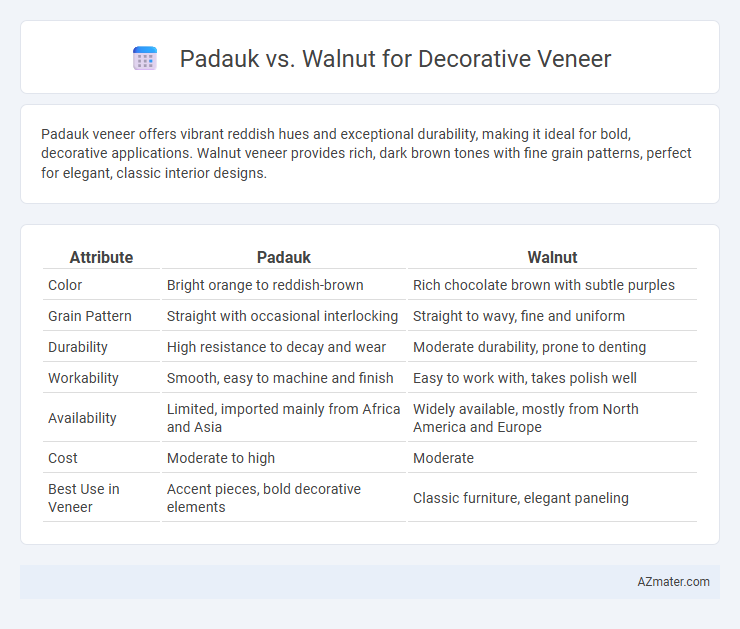Padauk veneer offers vibrant reddish hues and exceptional durability, making it ideal for bold, decorative applications. Walnut veneer provides rich, dark brown tones with fine grain patterns, perfect for elegant, classic interior designs.
Table of Comparison
| Attribute | Padauk | Walnut |
|---|---|---|
| Color | Bright orange to reddish-brown | Rich chocolate brown with subtle purples |
| Grain Pattern | Straight with occasional interlocking | Straight to wavy, fine and uniform |
| Durability | High resistance to decay and wear | Moderate durability, prone to denting |
| Workability | Smooth, easy to machine and finish | Easy to work with, takes polish well |
| Availability | Limited, imported mainly from Africa and Asia | Widely available, mostly from North America and Europe |
| Cost | Moderate to high | Moderate |
| Best Use in Veneer | Accent pieces, bold decorative elements | Classic furniture, elegant paneling |
Introduction to Padauk and Walnut Veneers
Padauk veneers, derived from the Pterocarpus genus, are celebrated for their vibrant reddish-orange hues and a fine, straight grain that adds warmth and richness to decorative surfaces. Walnut veneers, sourced primarily from Juglans nigra and Carpathian walnut species, offer deep chocolate-brown tones with intricate grain patterns, creating an elegant and classic aesthetic. Both hardwood veneers are prized for their durability and workability, making them popular choices in high-end furniture and interior design applications.
Origin and Botanical Background
Padauk, derived from species in the Pterocarpus genus native to tropical Africa and Asia, is renowned for its vibrant reddish-orange hue and dense hardwood properties. Walnut, primarily sourced from Juglans species native to North America and Europe, offers a rich brown coloration with fine, straight grain patterns ideal for decorative veneer. Both woods belong to distinct botanical families--Fabaceae for Padauk and Juglandaceae for Walnut--reflecting their unique growth environments and structural characteristics influencing veneer quality.
Visual Appearance and Color Comparison
Padauk veneer showcases a striking reddish-orange hue that deepens to a rich, dark red over time, creating a vibrant and exotic appearance ideal for bold decorative projects. In contrast, Walnut veneer offers a classic, warm brown coloration with subtle purple or gray undertones, exuding elegance and timeless sophistication. The visual texture of Padauk is typically more pronounced with straight grain patterns, while Walnut features a smoother, finer grain that enhances its refined appeal in interior design.
Grain Patterns and Texture Differences
Padauk veneer features bold, straight grain patterns with a fine, even texture that highlights its vibrant reddish-orange hue, making it ideal for striking decorative elements. Walnut veneer displays more varied grain patterns, including straight, wavy, and curly figures, with a smooth, slightly oily texture that emphasizes its rich chocolate-brown tones. The contrast in grain complexity and texture between Padauk's uniformity and Walnut's intricate patterns offers distinct aesthetic choices for high-end decorative veneer applications.
Durability and Hardness Analysis
Padauk wood exhibits a Janka hardness rating of approximately 1,410 lb, while Walnut registers around 1,010 lb, indicating Padauk's superior hardness and resistance to denting. In terms of durability, Padauk offers excellent natural decay resistance suitable for high-traffic environments, whereas Walnut is moderately durable but better suited for indoor decorative applications. The dense grain structure of Padauk enhances its wear resistance, making it ideal for veneers requiring long-lasting performance, whereas Walnut's softer texture provides a smoother finish preferred for aesthetic appeal.
Workability and Finishing Qualities
Padauk offers excellent workability due to its moderate density and straight grain, making it easy to cut, sand, and shape for decorative veneer applications. Walnut, with its fine, even texture and slightly harder density, provides a smooth finishing surface that enhances natural grain patterns and accepts stains uniformly. Both woods exhibit good finishing qualities, but walnut tends to yield a more consistent and polished look, while padauk's vibrant color deepens with finishing, adding unique visual appeal.
Cost and Availability Factors
Padauk veneer tends to be more affordable than walnut due to its faster growth rates and greater supply, making it a cost-effective choice for decorative applications. Walnut veneer, prized for its rich color and grain, commands higher prices and can be more limited in availability due to slower growth and stricter harvesting regulations. Availability of both woods varies regionally, but walnut generally requires careful sourcing, impacting its overall cost and accessibility for veneer projects.
Environmental Impact and Sustainability
Padauk veneer offers a vibrant reddish hue and is sourced primarily from tropical regions where sustainable harvesting practices are increasingly implemented to reduce deforestation risks. Walnut veneer, known for its rich brown color and fine grain, is often harvested from managed North American and European forests, promoting sustainable forestry certifications such as FSC and PEFC. Both species present environmentally responsible options when sourced from certified suppliers, but walnut's widespread availability and slower growth rate may impact long-term sustainability more heavily than the faster-growing padauk.
Popular Applications in Decorative Veneering
Padauk is widely favored for decorative veneer in high-end furniture, cabinetry, and musical instruments due to its vibrant reddish-orange color and durability. Walnut veneer is popular in luxury interiors, wall paneling, and custom furniture, prized for its rich chocolate-brown tones and elegant grain patterns. Both woods offer distinct aesthetic appeal, with Padauk providing bold color contrasts and Walnut delivering timeless sophistication in decorative applications.
Choosing the Right Veneer: Padauk vs Walnut
Padauk veneer offers vibrant reddish-orange hues and exceptional durability, making it ideal for bold, statement decorative pieces, while Walnut veneer provides rich, dark brown tones with intricate grain patterns favored for classic, elegant designs. Choosing the right veneer depends on the desired aesthetic impact and application environment, with Padauk excelling in high-traffic areas due to its hardness and Walnut preferred for refined, sophisticated interiors. Both veneers are prized for their stability and workability, but Walnut's subtle warmth contrasts Padauk's vivid coloration, influencing the final ambiance of the space.

Infographic: Padauk vs Walnut for Decorative Veneer
 azmater.com
azmater.com